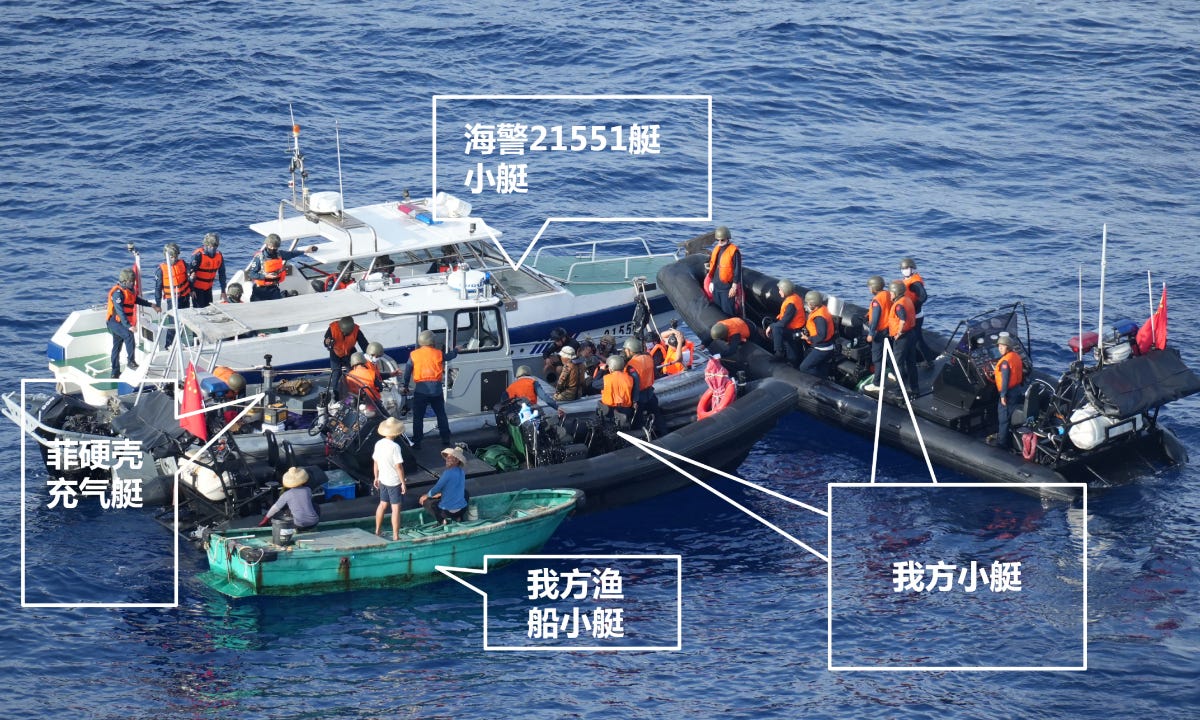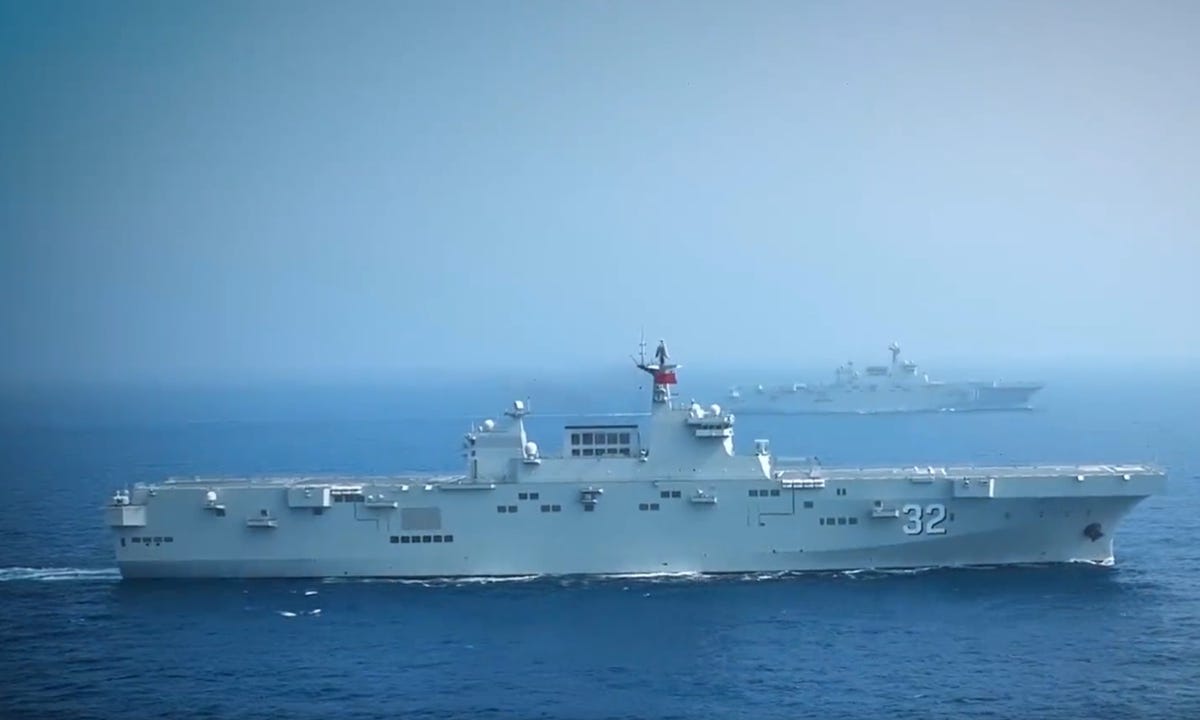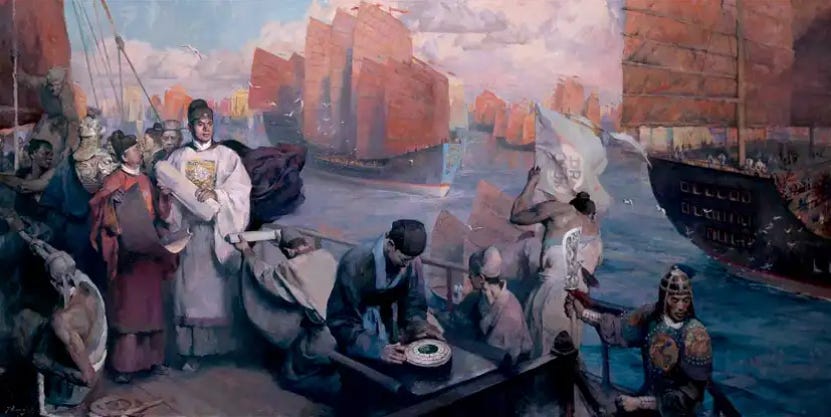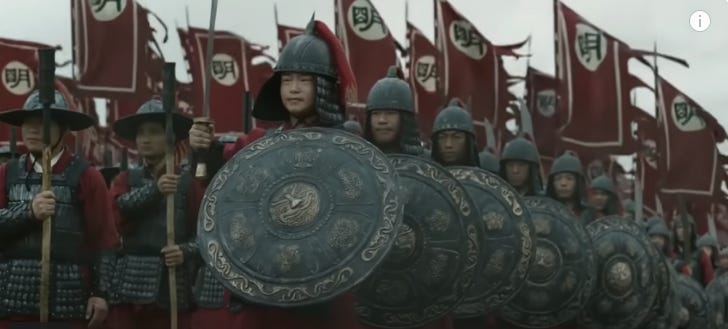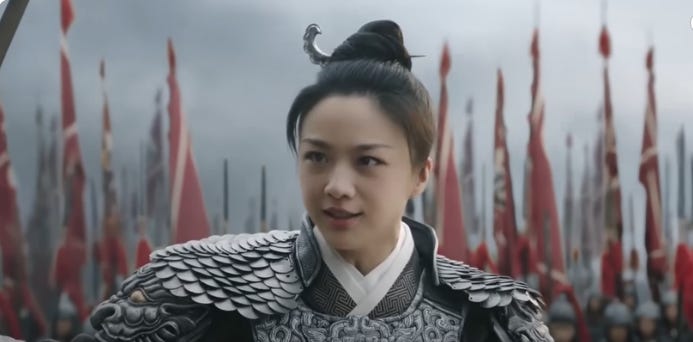China's Coming Showdown with the US
Sea change in China's security and foreign policies: Lessons of Ren'ai Reef, Ukraine & the return of the Great Ming to China.
*
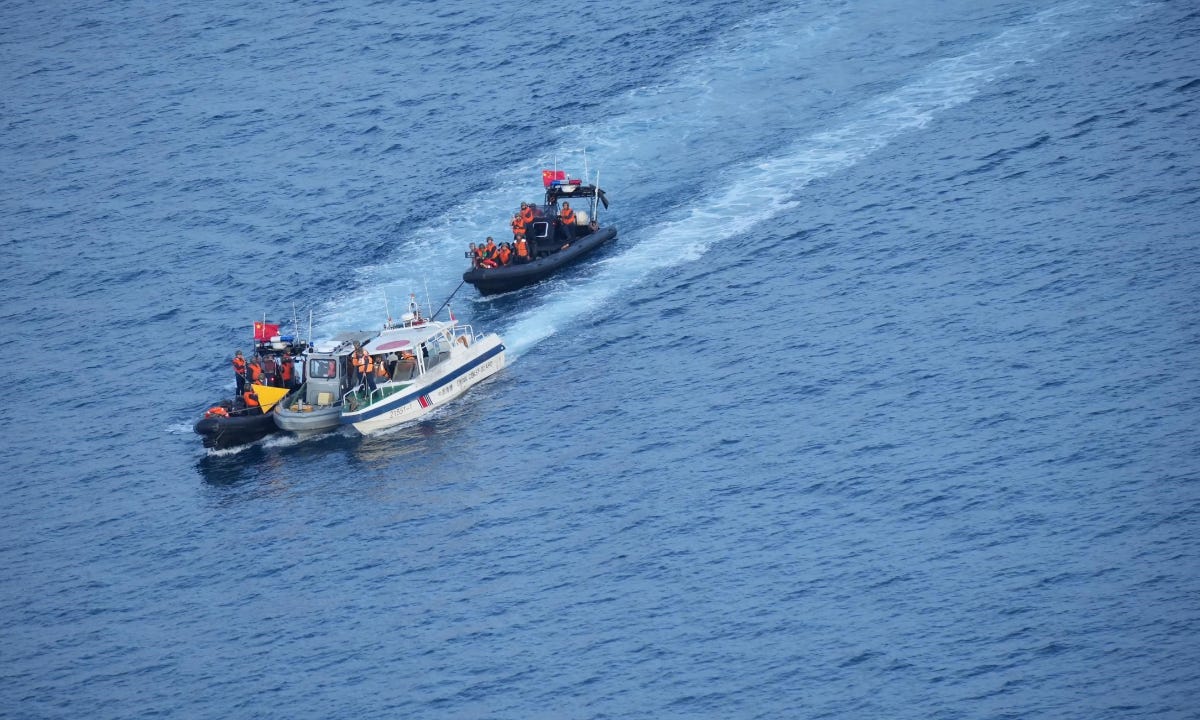
There were no attempts to get out of each other's way on June 17 between two large vessels, one of the Chinese Coast Guard and the other from Philippines that was headed with supplies into Ren'ai Reef, South China Sea (SCS). The Chinese marine police went even further, putting out a straight-jacket grip lock on a Filipino raft delivering the supplies, seizing its crew, and their guns.[1]
Not in living memory has there been such a head-to-head confrontation in the South China Sea (SCS), in particular one between China and a Southeast Asian neighbor (ASEAN), with amphibious assault ships waiting in the background.[2] Although China claims, and has territorial control of much of SCS for a thousand years, it has largely adopted a live and let live attitude with the neighbors. That is, until the White man arrived circa 1520.[3]
The last (really) big official Chinese enforcement action was 1407, carried out by Zheng He with an attack on the Palembang station of a renegade group through which the Guangzhou man Chen Zuyi 陳祖義 had for seven years (since circa 1400) control of the narrow Straits of Malacca (Melaka) sea traffic. The assault was followed by a sea hunt and more battles.
Those early days China made no bones about what they'd do once they caught up with the enemy: 5,000 were killed, an entire armada burned to cinders, and their only prisoner Chen Zuyi shipped back to China (Nanjing) where after a trial his head was, in public, chopped off from his body at dawn on October 2, 1407, skull location unknown till today.[4]
Chen's death also marked the beginning of the rise of the Melaka sultanate. Beginning because it became rich from shipping traffic and from taxes of goods that ran back and forth between the Indian and Arabian coasts, passing SCS, and into China proper. Ming shilu 明实录 accounts spoke much of that Melaka entrepot trade, the only written documentation of that era of a nation outside China.[5]
Granted exclusive trade rights with China was a big deal then. That jurisdiction gave Melaka the authority to collect taxes on Chinese inbound and outbound goods, receiving them (timber and incense) on China's behalf and reselling Chinese tea, porcelain, fabrics, iron and bronze wares.
This is exactly the same way Singapore had gotten rich today not because of its geographic centrality that history books falsely claims. Rather it was by commandeering the two-way sea trade traffic into its ports, especially goods on the China-Europe run. This was enabled by Singapore's pretense, among Europeans in particular, that ship and goods were insured-guaranteed and, in its turn, protected by the power of US naval and air forces operating in Singapore. The US bases were protecting a trade route from supposedly the Chinese although the traffic ran back and forth from China anyway.
Singapore knew to hitch its fortunes on American and Anglo-Saxon extortions. In effect, they were military pirates in briefcases and dressed as bankers, shipping and insurance agents. On land, Singapore operated like it were the turf upon which the Mafia turned up to collect money for protection of homes and businesses. They call it general, fire, war and theft, and life insurance.
No wonder then China's actions against the Philippine was met with total regional silence, in particular from its Southeast Asian neighbors; they are grouped under the name ASEAN.
Indeed, the day China released pictures (above) of its Ren’ai operations, prime minister Li Qiang visiting Malaysia was received with pomp and grandeur, and the King unusually granted him an audience. On his part, prime minister Anwar Ibrahim asked China to, please, quickly complete a 660-km high speed goods and passenger rail line, presumably before his term of tenure ends in 2028.
ASEAN's most despised member, Singapore, knew too well to keep its Anglophile mouth shut and their snake oil, forked tongue speeches to themselves.
While the Ren'ai Incident unfolded, Vladimir Putin came, a White Russian chief, stopping in the Democratic People’s Republic of Korea (DPRK) before reaching Vietnam on June 19. Along with notably Malaysia and Indonesia, Vietnam, too, is one of half-a-dozen SCS claimants on islands scattered on a vast ocean map (images below) that nobody else centuries ago knew how to use other than Chinese merchants and fishermen for stopover purposes to and from Java to replenish supplies and as typhoon shelters.
The Russians have never come this far south of the equator, not 500 years ago nor in the last 50 either. There has been no need for them in the region anyway — until now.
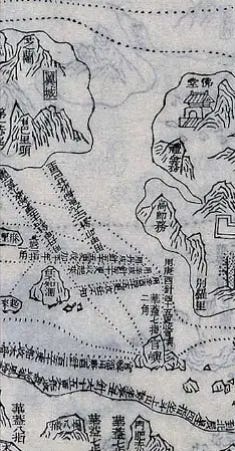
The fact that Putin is himself visiting, a two-in-one East Asia landing, is revealing not just of Russia's intent. Rather it coincides with a sea change in Chinese foreign policy, and in attitudes of themselves, their place in the world, and of the world itself.
Which is this: China can no longer live in the present – that is, the reality as is presently erected.
It is, in truth, an artifice of western construction wherein everything is inverted: black is white, falsehood is truth, the Mafia chief is the patron saint, the thief is the policeman. How, for example, is it possible for Vietnam to entertain Kamala Harris while pretending that America hadn't slaughtered 3 million of their people between 1965 and 1975. How long more will anyone tolerate a Philippines – or a Singapore – abetting that slaughter, and today still corroborating with the murderous US regime for an expansionist control of the seas where everyone had used with no trouble, whatsoever, for a thousand years?
And, worse still, is that the Pinoys and Singaporeans pretend to themselves to be more Anglophile than Americans are Anglo-Saxon, the beacons of light, peace and freedom, and yet they had never lit a single candle to the families of the 1,000 dead in the 1906 Bud Dajo Massacre on the island of Jojo.[6] Or, before that, the Dutch massacres at Banda, and later at Batavia (Jakarta), and on and on and on, generation after generation. What about the 20 million Chinese, dead from 1937-to-1949 through no fault of their own but for the failure and the betrayal of their own government?
Wherever the western Man turns up, there are the local scoundrels (think Eric Li) of course.
This recognition of the history-in-the-present, though three hundred years late in official China, leaves only one conclusion: the Chinese must reconstruct the present, with its own hands, by its own people, and to rebuild a way of life both moral and natural, without deceit and coercion.
There were momentous moments in Chinese history when a sudden surge of national effort was required both to recover territory and to restore its dignity. One such was the Jisi event 己巳之变 that led, in turn, to the Tumu crisis 土木堡之变 of September 1449.*
That moment has returned today.
It is the moment we Chinese must cease all self-deception, delusions and pretenses, any of which simply can't go on ad infinitum. Either we confront the US today, cut off the heads of the Chen Zuyi of the Philippines and America, or we die doing so. The Singaporean snake oil salesman must never be permitted a street corner to peddle lies. Do what they like in their own homes, even practise patricide, or sons sleep with mother, but never will their lives be lived at the expense of others.
The only way to annihilate western barbarian values is to annihilate the barbarian himself. (Also see related: Just Shoot that Whitey Bastard.)
In parallel to the words of the empress Tang Wei 汤唯太後, the White barbarian must be driven back from whence he had come. (See below marked asterisk*.)
Ren'ai marks the first tentative steps towards that final showdown with the US, directly in the South China Sea. It is proof to the Chinese that for sovereignty to be true, independence must be acted upon, not spoken off like the banging of an empty tin drum.
This, too, is what the Chinese had observed the Russians to be doing in Ukraine. It, first and foremost, jettisoned the pretense that the West is a friend or partner, then to name its enemies and, after that, pummel them out of the Russian life. This new Russian approach in dealing with the West has meant the following:
Willingness to meet force with force. (Ukraine)
Willingness to confront the US directly. (DPRK)
Openly and materially support friends hurt by the US.
Openly undermine the US, at home & at all institutions.
Openly contest presence of western colonial legacy wherever this is found.
Expand local red lines until they reach the California coastline.
Ren'ai is half-brother in that Ukranian moment.
Enough, China says, with the century of pretense because the consequence in that is just more misery – and that’s after the Pinoys and the Singaporeans have scammed you. If recognition of pretense is the first red line in defense, then a multi-faceted destruction of the West is the offense.
Should the US physically turn up then all the better: let's settle this once and for all. Either way, the call must be made, if not today then tomorrow: win or lose, you either stand up to the White man and his dogs or submit to him like the Pinoy.
Isn't that decision, the Chinese ask themselves, what national rejuvenation is also about, ultimately? Because it’s only after that, and only then, are we truly free, including to make our own history. (See, for example, a White man’s confession on European and American barbarity. Michael Parenti, "Racism and the Ideology of Slavery: From Aristotle to George Bush", lecture delivered in Berkeley, California, June 1992.)
***
The One-Hundred Years Speech
*Depicted in film The Daming《明王朝》or The Great Ming, the 1449 Tumu crisis had to be resolved by 汤唯太後 the empress Tang Wei herself (see clip below), who rallied the troops in a speech that paralleled Xi Jinping's remarks, “changes not seen in 100 years.” According to the Ming shilu, China survived the crisis and went on to become a superpower with peace to last another 400 years before the inept and corrupt Qing government lost everything after 1840.
***
NOTES & REFERENCES
For news reports on the Ren'ai Incident:
https://www.globaltimes.cn/page/202406/1314408.shtml,
https://www.rt.com/news/599498-china-philippines-vessels-collision/ Bottom of this page, a sample of Taiwan’s hourly TV reports on Ren’ai, one of which says, Philippines has lost the fight and so resorts to farting in their media more than it has guns firing water.
For China's open challenge to the US and its Filipino lapdog, including the deployment of amphibious assault ships, see:
America's response to an open challenge from China was to use India hiding the Dalai Lama. See:
https://www.rt.com/india/599566-nancy-pelosis-meeting-with-dalai/
Account in the Ming shilu 楊士奇. 《明實錄·太宗文皇帝實錄·卷七十一》 第987頁:
“壬子,太監鄭和使西洋諸國還,械至海賊陳祖義等。初,和至舊港遇祖義等,遣人招諭之。祖義詐降,而潛謀要刧官軍。和等覺之,整兵提備。祖義率衆來刧,和出兵與戰,祖義大敗。殺賊黨五千餘人,燒賊船十艘,獲其七艘及偽銅印二枚,生擒祖義等三人。既至京師,命悉斬之。”
The Ming shilu 明实录 (explained, for example, in https://hub.hku.hk/bitstream/10722/42537/1/56512.pdf) is a daily official record of daily events and happenings passing through the Ming courts, 1368-1644, in particular official correspondences, edicts, legal instructions, minutes of meetings, conferences, and so on. Those records are mandatory, required by law as part of Chinese governance since before Qin China, 221BCE.
See, for example, https://www.historyisnowmagazine.com/blog/2023/4/16/the-bud-dajo-massacre-an-american-war-crime-in-the-philippines.
***

